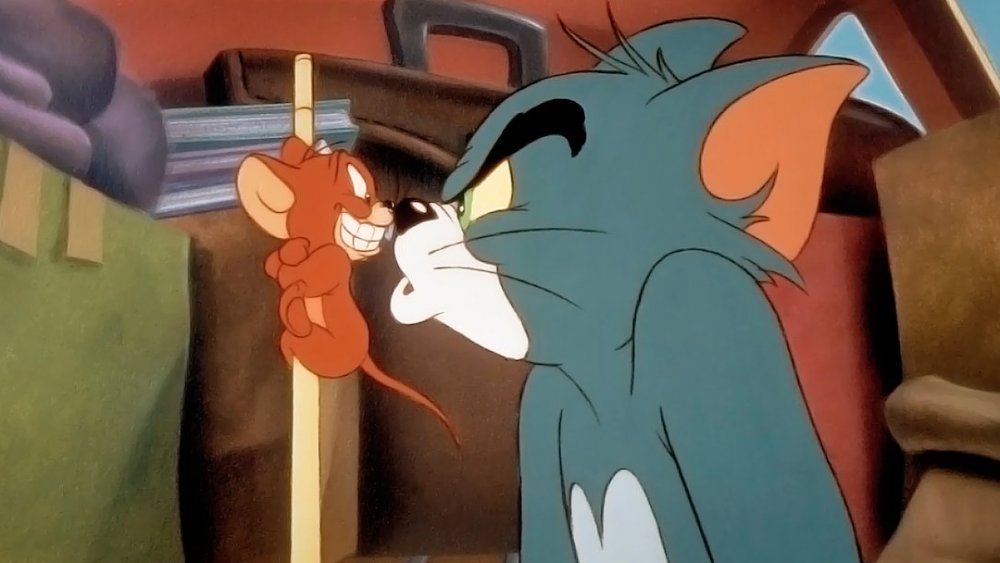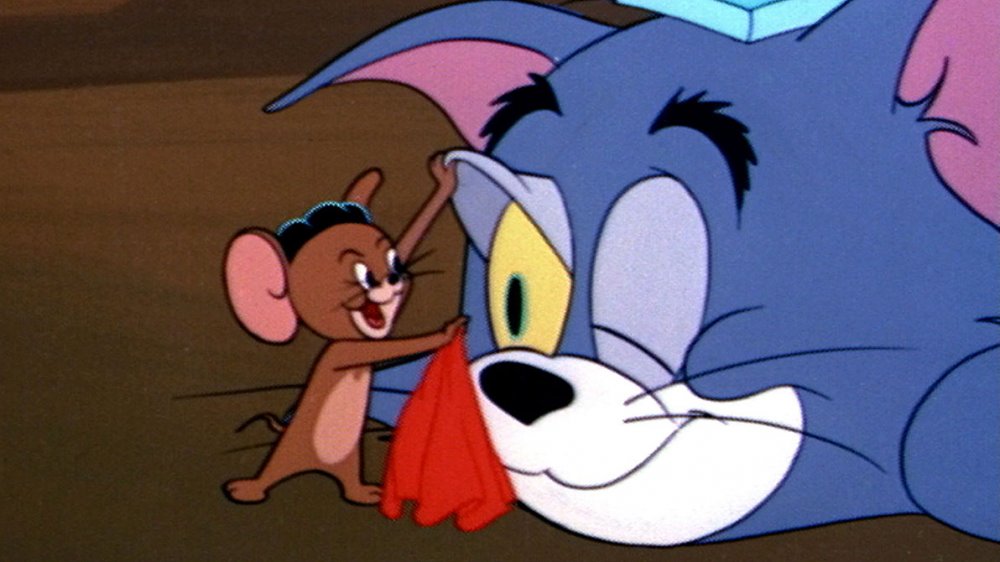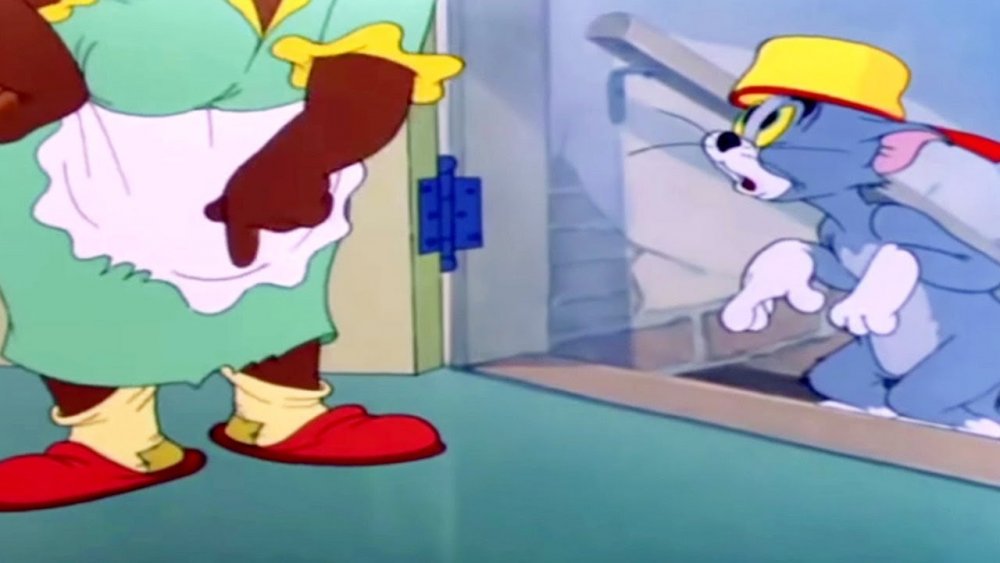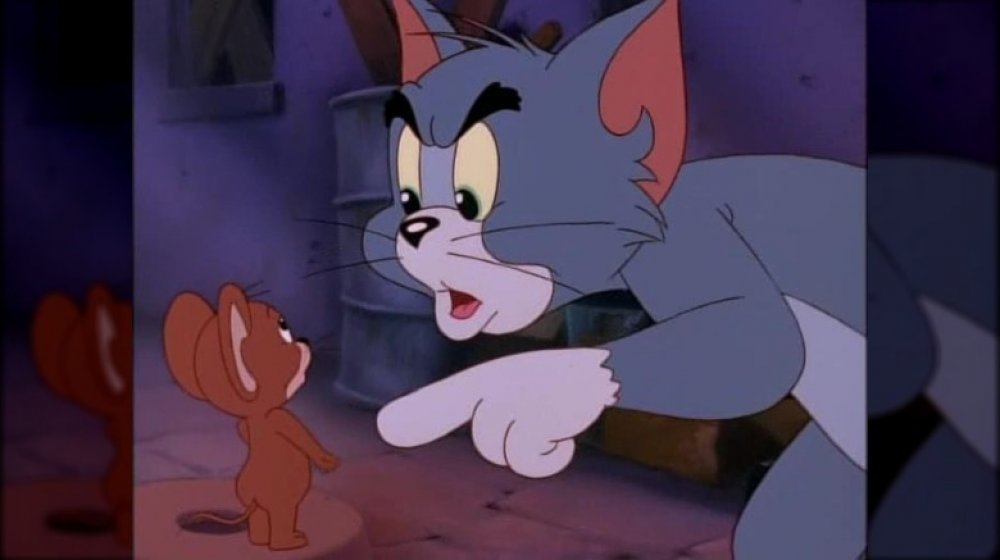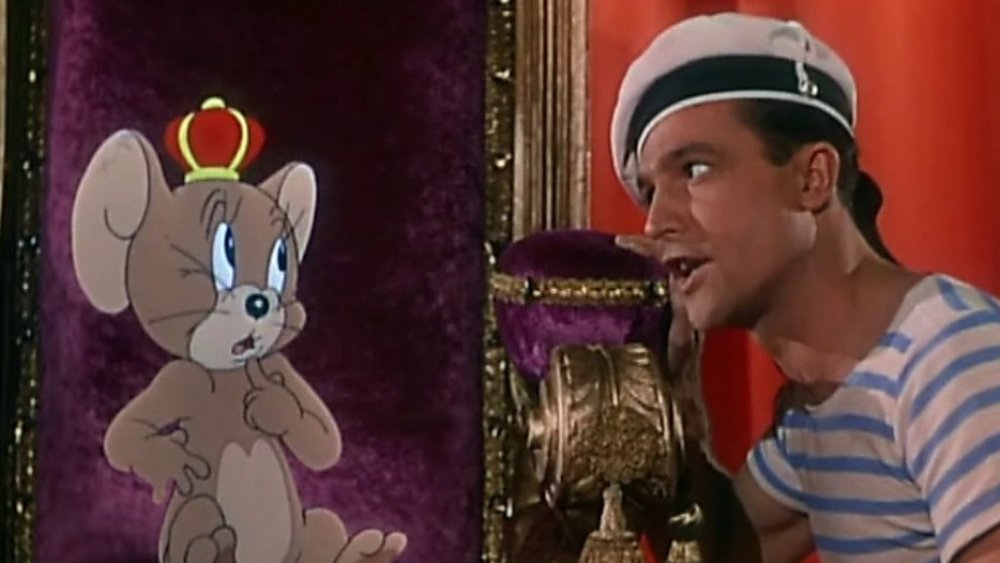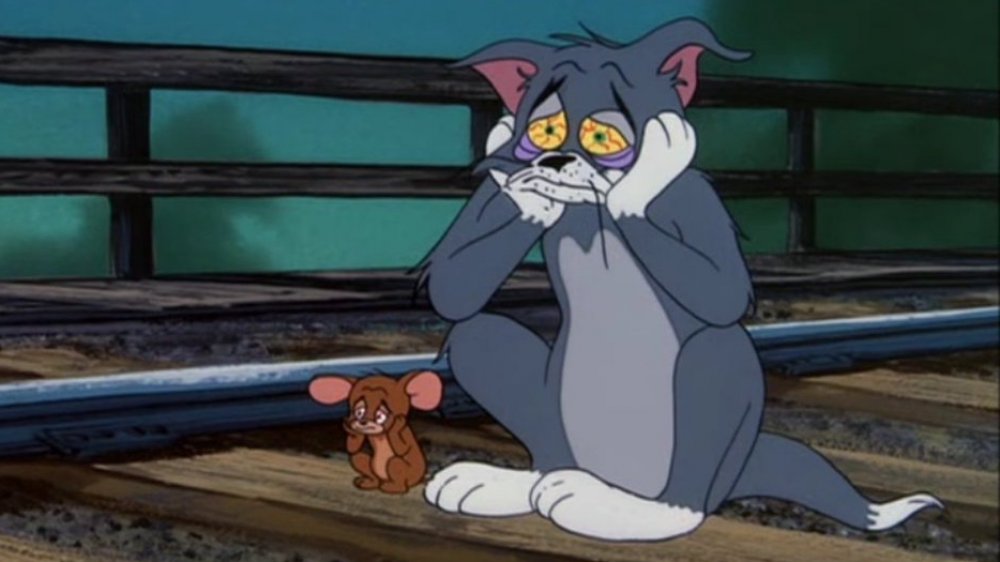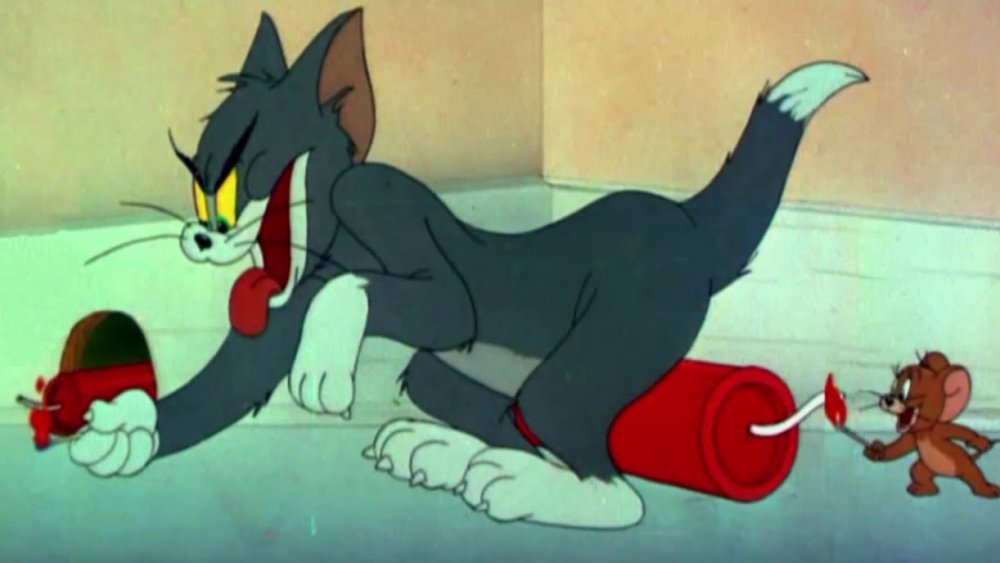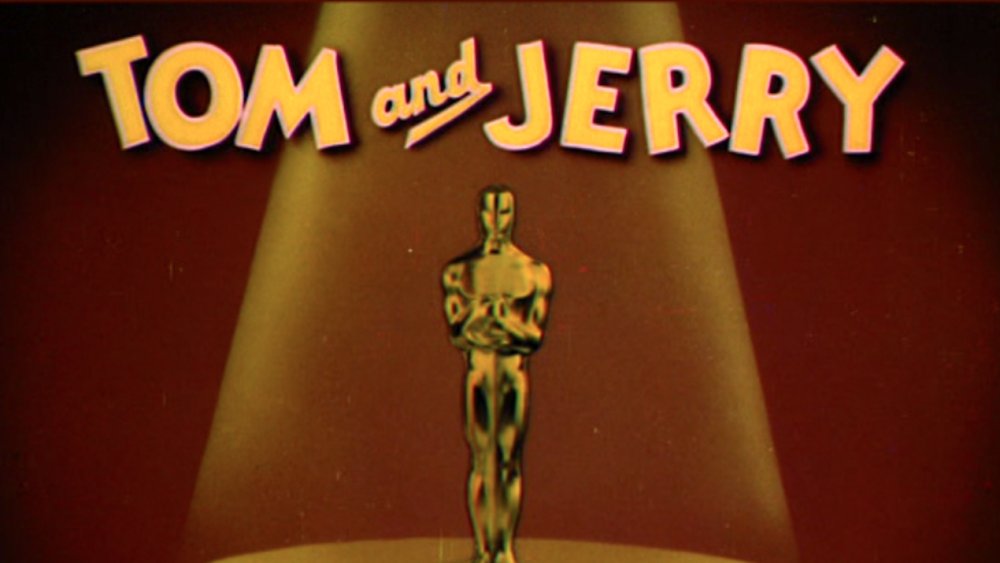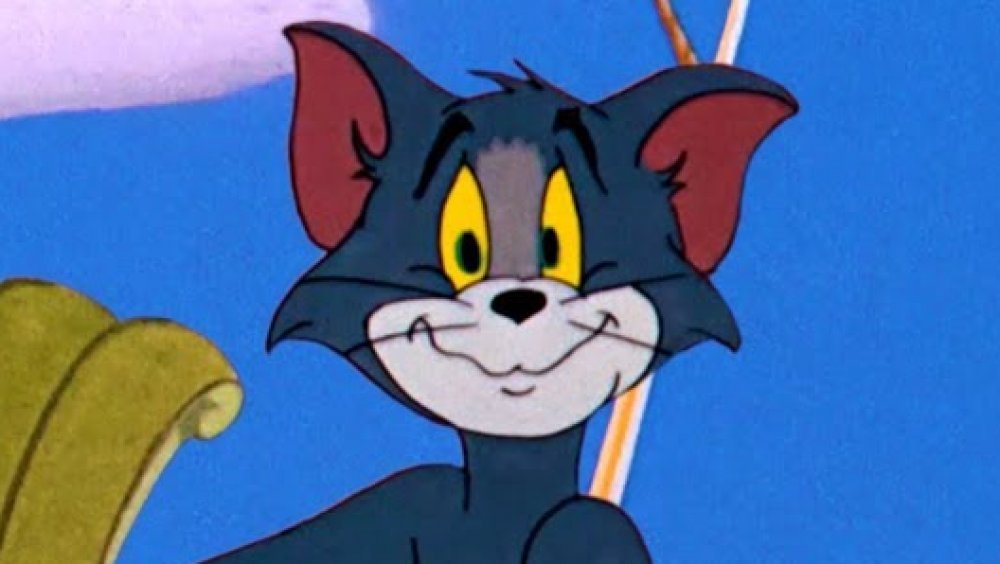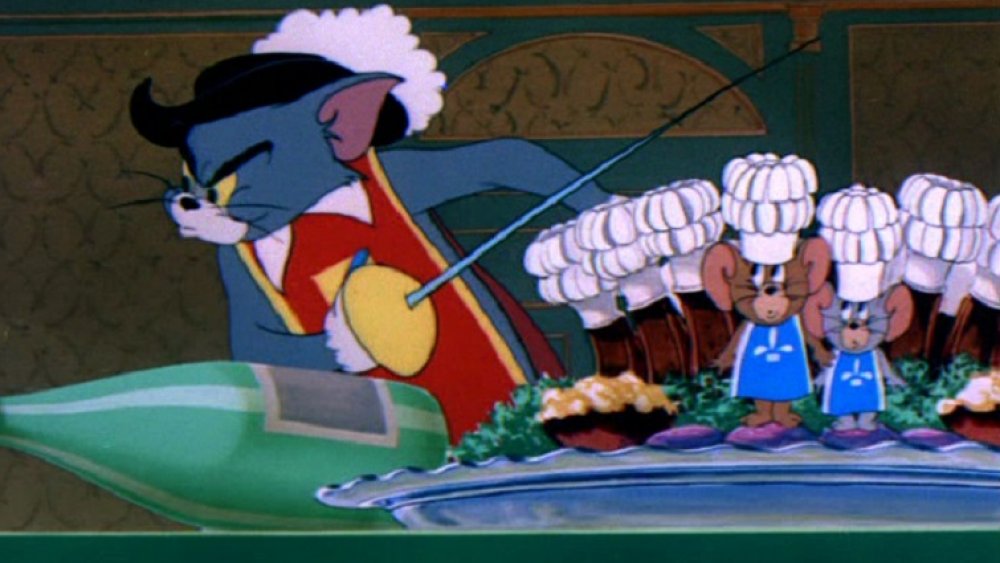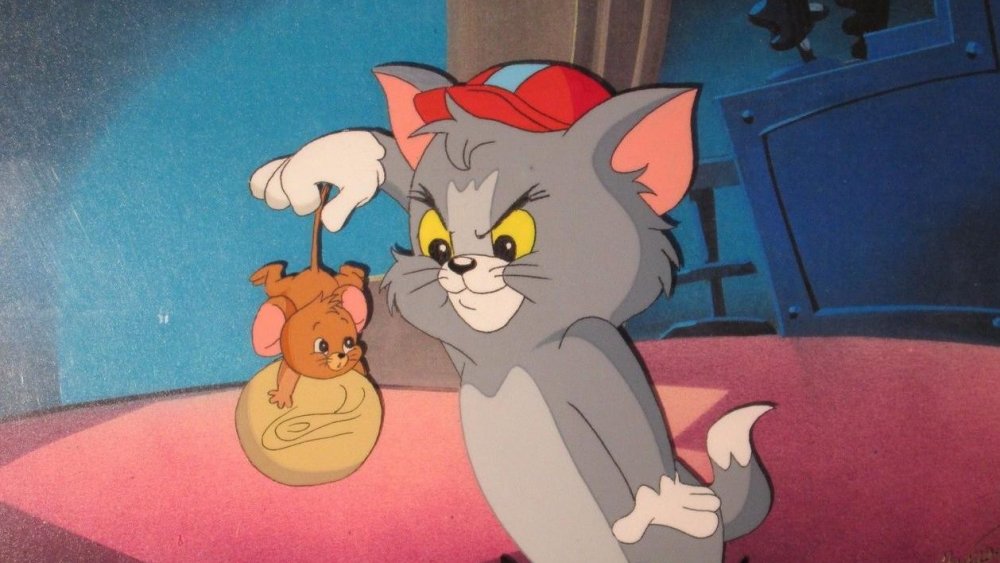The Untold Truth Of Tom And Jerry
There aren't many cartoon series that are older or more enduring than Tom and Jerry. From the early 1940s to the late 1950s — the quintessential era of lushly animated, beautifully scored short cartoons that screened in movie theaters before a film — a grey cat named Tom and a brown mouse named Jerry fought each other to the near-death dozens of times. Why? Well, Tom was a cat, and Jerry was a mouse. It's the natural order of things. Also, Jerry was much smarter than Tom and tended to always foil the cat's plots and inflict just as much violence in return (or more).
Head-to-head animated combat, pop culture duos, and delightful mayhem just wouldn't be the same had Tom and Jerry not laid out the template 80 years ago. And the two characters have lived on in TV reruns and numerous revivals and re-creations, from brand new cartoon series to feature films. And today, we're taking a look at some little-known details about their long, wild history. From their award-winning achievements to their strange feature film, here's the story of the original cutthroat cat-and-mouse cartoon pair.
Would Jasper and Jinx have been as successful?
"Tom" and "Jerry" sound like two perfectly generic, ethnically vague, mid-20th century American male names. In other words, they were perfect for the names of a stylistically simple cartoon cat and mouse. But creators William Hanna and Joseph Barbera didn't come up with those names — the ones for their iconic, undying creations — until after they'd already produced a cartoon about the pair. The first Tom and Jerry cartoon, 1940's "Puss Gets the Boot," is actually a "Jasper and Jinx" toon. Jasper was the name of the cat and Jinx the name of the mouse. Hanna and Barbera just didn't think those monikers suited their creations, and seeking ideas from crew members, they went with animator John Carr's suggestion of Tom and Jerry.
Carr didn't invent that pairing of words that just happen to sound good together. "Tom and Jerry" was a phrase floating around the English language for more than a century. In 1821, British writer Pierce Egan wrote Life in London, the stories of a couple of roustabout toughs named, you guessed it, Tom and Jerry. The book was so successful that it inspired a stage play and a boozy eggnog cocktail called the Tom and Jerry that would ultimately outlast the popularity of the source material.
A main character was edited out decades ago
In the late 19th century and into the early 20th century, crude, broad, and terrible stereotypes of African-American characters were common in popular culture. Holdovers from both the slavery-era South and vaudeville, this included things like white performers donning "blackface" and adopting certain vocal patterns to both embody and mock African-Americans, along with character archetypes like the one known as "mammy" — generally a heavyset, older African-American woman working as a cook, maid, or servant. Such cultural norms persisted well into the 1940s and 1950s. And sadly, Tom and Jerry cartoons of that era featured a stereotypical character named Mammy Two Shoes, who worked in Tom and Jerry's house and would show up to yell at Tom when she caught him doing something bad.
Mammy Two Shoes appeared in the first Tom and Jerry short, "Puss Gets the Boot," and then showed up in 18 more. Fortunately, she was retired after the 1952 cartoon "Push-Button Kitty." But anyone who saw Tom and Jerry cartoons on TV likely never saw Mammy Two Shoes. As times progressed and the presence of characters like Mammy Two Shoes was scrutinized as both outdated and racist, the character was edited out of the prints shown on TV.
The 1992 Tom and Jerry movie was a misbegotten bomb
While cartoon shorts starring Tom and Jerry screened in movie theaters in the 1940s and 1950s (before the feature film), the cat-and-mouse will be the main attraction in a movie combining live-action and computer animation set for release in December 2020 by Warner Animation Group. However, this upcoming Tom and Jerry isn't the first full-length, big-screen adventure for the classic duo. In 1992, Tom and Jerry: The Movie hit theaters, and it was such a critical and commercial flop that it quickly faded into obscurity and faded from the collective memory.
The failure may have resulted from a total mishandling of the characters. The original cartoons were fueled by Tom and Jerry's silent and violent rivalry, but Tom and Jerry: The Movie made the pair, as Variety said, "buddies singing, dancing, and doing battle together against the world." Tom and Jerry were friends, and they talked, and the dark plot found them trying to assist an abused little girl. No thanks, said moviegoers, as Tom and Jerry: The Movie grossed just $3.5 million during its brief theatrical run.
When Jerry met Gene Kelly
When it comes to seamlessly combining filmed footage of human actors with animated characters, the most impressive movie ever made has to be Who Framed Roger Rabbit. This 1988 movie so convincingly inserted real-life actors like Bob Hoskins (as gumshoe Eddie Valiant) into the classic animation world of Toon Town that animation director Richard Williams received a special Academy Award for his efforts.
But Roger Rabbit might not have happened without Anchors Aweigh. This 1945 musical about sailors having some adventures on shore leave starred Frank Sinatra, Gene Kelly, and in a fantastical storytelling sequence, Jerry from the Tom and Jerry series. Kelly's character spins a tale about how he met and helped out a lonely mouse king, and the two dance on-screen together, their moves immaculately synchronized through the dual powers of human choreography and intensive animation, then mashed up together in an editing room.
There's a dark urban legend about the final Tom and Jerry cartoon
Despite a lack of evidence — and how a few minutes of internet research can easily prove or disprove most anything — urban legends and myths about pop culture persist. There's even an especially dark one about Tom and Jerry. Reportedly, the final Tom and Jerry cartoon ends with a real and disturbing finality, with both characters killing themselves by way of lying down on train tracks and getting run over.
Yep, Tom and Jerry commit suicide. However, like about 99 percent of urban legends, this isn't true, but some nuggets of truth have been exaggerated. In the 1956 short "Blue Cat Blues," Tom gets incredibly despondent when his girlfriend leaves him for another cat, and Jerry tries to pull him out of his funk, only to have his best mouse gal pal dump him, too. The episode ends with them both sitting on tracks while a train approaches. But the cartoon doesn't actually depict their deaths. Nor do they really die, because plenty more Tom and Jerry cartoons were produced after "Blue Cat Blues," well into the '60s. Still, that's a pretty dark show for kids.
Tom and Jerry was extremely influential
Tom and Jerry are pop culture pioneers, one of the first cartoon duos that operated on an endlessly repeatable formula (that somehow never got old), in which they engaged in constant bloodless war. Tom and Jerry predate (and certainly influenced) plenty of other cartoon adversaries, such as Wile E. Coyote and the Road Runner, Sylvester and Tweety, and Itchy and Scratchy (the extraordinarily violent show-within-a-show-within-a-show about a cat and mouse on The Simpsons).
Its gleefully nihilistic tone can also be found in Jackass. In fact, the cat and mouse not only helped co-creator and star Johnny Knoxville recover between movies, but they got him ready for more. "I just get an overwhelming urge. I find myself watching Tom and Jerry and Buster Keaton films a lot, and then just jotting stuff down, and then the next thing I know, I'm like, 'F***.' I just want to get the guys together immediately and start shooting," Knoxville told Vice.
These two have won a ton of Oscars
Tom and Jerry is often thought of as frivolous entertainment for children. It's simply something pleasant and familiar that's aired on television, both on kids networks and on local stations, for decades on end. However, this iconic cat and mouse have a bit more prestige than you might expect.
Tom and Jerry cartoons started production in 1940, well before the advent of TV, and they were shown in movie theaters. That made Tom and Jerry shorts eligible for Academy Awards, specifically the category of Best Animated Short Film. And the cat and mouse absolutely dominated the field. Between 1940 and 1954, 13 Tom and Jerry shorts (counting "Puss Gets the Boot") received Oscar nominations. Crazier still, Tom and Jerry won the Academy Award seven times, including a four-year victory streak (1943–1946) and one in 1949, when "The Little Orphan" beat another Tom and Jerry cartoon, "Hatch Up Your Troubles." Of the many theatrical cartoon franchises of the pre-television era, no one received more awards show hardware than Tom and Jerry.
Tom and Jerry has been blamed for a lot
Tom and Jerry cartoons feel like they're about as innocent as cartoons get. After all, they were made in the 1940s and 1950s, they were shown to kids for decades, and they aren't nearly as violent as the stuff kids are into these days. Half the superhero cast of Avengers: Infinity War dies, after all.
But Tom and Jerry cartoons are hardly innocuous. Over the years, individual installments have been heavily edited or straight-up banned by TV networks around the world. The cartoon franchise received its most fervent criticism from Salah Abdel Sadek, head of the State Information Service of Egypt. At a speech at Cairo University in 2016, the official claimed that Tom and Jerry cartoons depicted "the violence in a funny manner and [sent] the message that, yes, I can hit him ... and I can blow him up with explosives," thereby normalizing violence to viewers. Sadek believes that Tom and Jerry are partly responsible for the epidemic levels of violence that's plagued the Middle East for decades, which is ... quite a claim.
Tom and Jerry: The Musical is a thing that exists
Theatrical producers can make a musical out of almost anything. There was a Spider-Man musical on Broadway for a while, and the most popular thing on the stage in ages is Hamilton, the story of the founding of the United States as told through hip-hop. One of the longest running Broadway shows of all time is Cats, a loosely connected string of vignettes starring people writhing around in cat costumes. And when it comes to weird animal suits and head-scratching weirdness, you could say that Cats is a predecessor for the stage musical version of Tom and Jerry.
Spanish stage director Leandro Panetta put the whole thing together for a run in Buenos Aires, Argentina, in 2011, based on the Tom and Jerry cartoons "The Two Mouseketeers" and "The Cat Above and the Mouse Below," and he also included a re-creation of Jerry's dance with Gene Kelly from Anchors Aweigh. According to a synopsis translated from Spanish (from Cartoon Brew, via The Mary Sue), Tom and Jerry engage in "songs, chases, jokes, games, and stunts" and "travel from opera to medieval times, then run and chase from the living room into the garden." Well, okay then.
Tom and Jerry spawned multiple spinoffs
Tom and Jerry was one of the first name brands in cartoons, and various studios churned out shorts featuring the cat and mouse at each other's throats from 1940 to 1967. But Tom and Jerry never really went away after they stopped starring in theatrical shorts. A library of nearly 200 cartoons was packaged for television, and these episodes have been rerun countless times since. Those old toons always being on TV kept Tom and Jerry in the collective consciousness, creating a demand for new material starring the duo, no matter how much of a stretch it could be.
For example, in September 1975, The New Tom and Jerry Show hit ABC's Saturday morning schedule. The first Tom and Jerry show made specifically for television, it was different from the theatrical cartoons in that Tom and Jerry didn't chase each other around a house all day, but they were friends who traveled around the world and played sports, sailed with pirates, joined the circus, solved mysteries, and worked as movie stuntmen. That show lasted only 16 episodes, about a quarter as many as the successful early '90s Fox Kids series Tom & Jerry Kids Show. Cashing in on the animation fad of infantilizing well-known characters (e.g. Tiny Toon Adventures, Muppet Babies, Flintstone Kids), this series featured adorable toddler versions of Tom and Jerry. They still tried to kill each other, only in not quite such a violent manner as they would in their adult versions.
